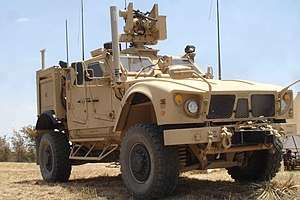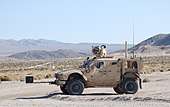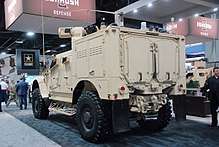Oshkosh M-ATV
The Oshkosh M-ATV is a Mine Resistant Ambush Protected (MRAP) vehicle developed by the Oshkosh Corporation for the MRAP All Terrain Vehicle (M-ATV) program. Intended to replace M1114 HMMWVs, it is designed to provide the same levels of protection as the larger and heavier previous MRAPs but with improved mobility.[4]
| Oshkosh M-ATV | |
|---|---|
 An Oshkosh M-ATV in July 2011 | |
| Type | Mine-resistant ambush protected vehicle (MRAP) |
| Place of origin | United States |
| Service history | |
| Used by | See Operators section below |
| Wars | War in Afghanistan Syrian Civil War[1] Yemeni Civil War[2] |
| Production history | |
| Designer | Oshkosh / Plasan |
| Designed | 2009 |
| Manufacturer | Oshkosh Corporation |
| Unit cost | $470,000+ |
| Produced | 2009–present |
| No. built | approaching 10,000[3] |
| Specifications | |
| Mass | Curb weight: 27,500 lb (12,500 kg) Gross weight: 32,500 lb (14,700 kg) |
| Length | 246.8 inches (6,270 mm) |
| Width | 98.1 inches (2,490 mm) |
| Height | 105 inches (2,700 mm) |
| Crew | 4+1 gunner |
| Armor | Plasan composite |
Main armament | 1× 7.62×51mm NATO (.308 in) M240 machine gun,[4] 1× 40 mm Mk 19 grenade launcher,[4] |
| Engine | 7.2 liter inline-6 Caterpillar C7 turbodiesel 370 bhp; 925 lb-ft |
| Power/weight | 23 hp/ton |
| Payload capacity | 4,000 pounds (1,800 kg) |
| Transmission | Allison 3500SP, 6-speed automatic with manumatic shifting |
| Suspension | 4x4, TAK-4 independent suspension |
Operational range | 320 miles (510 km) |
| Maximum speed | 65 miles per hour (105 km/h) (electronically limited) |
History
Requirements and selection

In the summer of 2008, the U.S. Department of Defense (DoD) began to examine the possibility of developing and procuring a lighter-weight, all-terrain capable MRAP variant to address the poor roads and difficult terrain of Afghanistan. Source selection activity considered responses from more than 20 companies to a Request for Information (RfI)/Market Survey dated 21 August 2008 and in mid-November 2008 the U.S. government issued a pre-solicitation for an M-ATV. In early December 2008 the M-ATV formal Request for Proposals (RFP) was issued. The original M-ATV program requirement was for between 372 and 10,000 vehicles, with the most probable production quantity stated as 2,080.[10]
In March 2009, it became known that two each of six different vehicle types (from five manufacturers) had been delivered to the U.S. Army for two months of evaluation, at the conclusion of which up to five ID/IQ (Indefinite Delivery/Indefinite Quantity) contracts would be awarded.[11] In addition to Oshkosh's proposal, BAE Systems submitted two proposals, these being a Joint Light Tactical Vehicle (JLTV) derived design and an FMTV-based Caiman derivative. Force Dynamics (a Force Protection/General Dynamics Land Systems (GDLS) joint venture) offered Cheetah, GDLS-C (Canada) offered an RG-31 MRAP derivative, and Navistar offered an MXT-based solution.[12]

After GDLS-C's RG-31 was eliminated from the competition in May 2009, it was announced that the five remaining bidders had been awarded ID/IQ contracts, and were each to deliver three production-ready test vehicles for the next stage of the competition. At the completion of testing, the U.S. DoD stated that it planned to select a single M-ATV producer but could, at its discretion, place production orders with multiple producers as it had done with the initial MRAP procurement. On 30 June 2009, the M-ATV contract award was announced with a single ID/IQ contract award to Oshkosh.[13][14][15] Brigadier General Michael Brogan, United States Marine Corps program officer for MRAP, stated that the Oshkosh M-ATV was chosen because it had the best survivability and Oshkosh had the best technical and manufacturing capabilities of all the competitors. The Oshkosh bid was also the second cheapest.[16][17][18]
The initial M-ATV delivery order was valued at over $1 billion and included 2,244 M-ATVs. The overall M-ATV requirement had increased in early June from 2,080 to 5,244 M-ATVs, these split 2,598 (Army), 1,565 (Marines), 643 (U.S. Special Operations Command), 280 (Air Force), 65 (Navy), and 93 for testing.[19]
Production and refurbishment

In July 2009, the first 46 M-ATVs were delivered, and in November the 1,000th M-ATV was handed over. Oshkosh reached its contractual obligation to produce 1,000 M-ATVs per month ahead of schedule in December 2009, and by using its existing manufacturing facilities in Oshkosh, WI (50%), and making use of its recession-hit JLG telescopic handler facility in McConnellsburg, PA (50%).[20] The first vehicles arrived in Afghanistan in October 2009 and were to be all delivered by March 2010.[21]
In total 8,722 M-ATVs were delivered to the U.S. Army, U.S. Marine Corps, U.S. Air Force, and U.S. Special Operations Command (SOCOM). M-ATVs were delivered in two main variants. The base model is designated M1240 with the Objective Gunner Protection Kit [OGPK] manned turret; it is designated M1240A1 when fitted with the Underbody Improvement Kit (UIK). The second main variant is designated M1277 and is fitted with M153 CROWS remote-controlled weapon station (RCWS). Produced in smaller numbers, the SOCOM-specific variant is designated M1245; M1245A1 with UIK fitted.[22]
As part of the overall divestiture of the MRAP fleet, the U.S. Government will keep about 80% (around 7,000) of the M-ATV fleet, 5,651 of these (inc. 250 for SOCOM) to be retained by the Army.[22] Work is currently underway at Oshkosh's Wisconsin facility and the Red River Army Depot to reset the around 7,000 M-ATVs retained to a common build standard. Oshkosh was awarded an initial 500-vehicle M-ATV Reset contract in August 2014. Three additional contract options for 100 vehicles each were awarded in December 2014. Total contract value is in excess of US$77 million. Deliveries were scheduled to continue through September 2015.[22]
Reset work centers on returning vehicles to Low Rate Initial Production (LRIP) 22 standard: essentially the build standard for the final M-ATV production batch. LRIP 22 includes upgrades such as the UIK and enhanced Automatic Fire Extinguishing System (AFES). Reset work also adds Engineering Change Proposals (ECPs) that include acoustic signature reduction (muffler), Modular Ammunition Restraint System (MARS) ammunition storage, and some Government Furnished Equipment (GFE) relocation.[22]
On 28 May 2015, Oshkosh announced the U.S. Army had awarded it a contract modification for the reset of 360 additional M-ATVs. The modification includes options for the reset of up to 1,440 additional M-ATVs. Deliveries for this latest modification started October 2015. Oshkosh is on contract to reset a combined 1,160 M-ATVs with a total value of over $115 million.[23]
In January 2017, the US Marine Corps disclosed that they would upgrade and refurbish around 80 M-ATVs over a five-month period, the work scheduled to take three to four weeks for each M-ATV and cost around $385,000 per vehicle, with both Marine and Air Force M-ATVs involved. The main difference between the two services M-ATVs is the armament; Air Force M-ATVs are fitted with a CROWS (Common Remotely Operated Weapon Station), while Marine M-ATVs are fitted with a manual OGPK (Objective Gunner Protection Kit) turret.[24]
Developments
At the Association for Unmanned Vehicle Systems International (AUVSI) 2013 convention, Oshkosh announced the integration of the TerraMax system onto the M-ATV to allow the type to be converted into an unmanned ground vehicle. The goal is to use the M-ATV as an unmanned platform for route clearance and counter improvised explosive device (IED) missions by engineers.[25]
Oshkosh Defense unveiled the M-ATV Extended Wheel Base Medical (EXM) variant at the International Defense Exhibition and Conference (IDEX) 2015 (22–26 Feb.) in Abu Dhabi, United Arab Emirates. This variant of the M-ATV has enough interior capacity to simultaneously transport two litter-bound patients, two ambulatory patients, a medic, commander and driver. The M-ATV EXM's customizable internal configuration also enables equipment to be accessed quickly by a centrally positioned medic.[26]
In February 2015, Oshkosh Defense and Alliant Techsystems conducted a firing demonstration of the M230LF 30 mm chain gun on an M-ATV to demonstrate the viability and effectiveness of a medium caliber weapon system for light tactical vehicles. The live fire demonstration showcased improved accuracy in mobile engagements and improved lethality on the M-ATV using the gun, mounted on the R400S-Mk2, a 3-axis stabilized remote weapon station weighing less than 400 kg (880 lb). The addition of the 72.6 kg (160 lb) M230LF stabilized on the RWS provides mobile precise lethality, usually reserved for heavier combat vehicles, with exceptional off-road mobility and MRAP levels of protection.[27]
The M-ATV proved to be more survivable than the Humvee and was lighter than other MRAP versions, but to further enhance survivability and mobility for troops, the U.S. military undertook the Joint Light Tactical Vehicle (JLTV) program to obtain a vehicle combining light weight, mobility, and protection. In August 2015, Oshkosh was awarded the contract for their Light Combat Tactical All-Terrain Vehicle (L-ATV), which took design lessons from fielding the M-ATV and incorporated them into a truck at two-thirds the weight and with faster off-road speeds.[28]
By 2018, the Marine Corps was deploying a Counter-Unmanned Aerial System (C-UAS) that can be mounted onto an M-ATV. The Ground-Based Air Defense (GBAD) Counter-UAS system consists of the RPS-42 S-band radar, the Modi electronic warfare system, visual sensors and Raytheon Coyote anti-drone UAV to detect, track and destroy hostile drones.[29]
Design

The M-ATV combines a Plasan designed armored hull developed for the Northrop Grumman/Oshkosh JLTV Technology Development (TD) phase proposal[30][28] with some elements of the Medium Tactical Vehicle Replacement (MTVR) chassis and Oshkosh's TAK-4 suspension system. TAK-4 suspension is coil sprung and fully independent, and offers 16 inches of wheel travel.
For survivability, and in addition to the V-shaped hull which is optimized for IED protection, other aids include the ability to take a 7.62 mm round to the engine oil/coolant/hydraulic system and continue to drive for at least one kilometer. The engine compartment is also protected with the Stat-X engine fire suppression system.[31] A central tire inflation system (CTIS) and run-flat inserts allow the M-ATV to travel at least 30 miles at 30 mph even if two tires lose pressure. The M-ATV also features a traction control system and anti-lock brakes.
Armament is roof-mounted and can be either manually or remotely operated. Manual options include a M240 machine gun, a Mk 19 grenade launcher, an M2 Browning machine gun, a MILAN anti-tank guided missile, or a BGM-71 TOW anti-tank guided missile launcher. Remote option is usually the CROWS (Common Remotely Operated Weapon Station), however as previously mentioned, Oshkosh has also fitted for demonstration purposes the R400S-Mk2, a 3-axis stabilized remote weapon station.
Other M-ATV features include a HVAC system and power outlets for charging portable electronic devices.[4] The M-ATV is also unique among MRAP-type designs in that it uses suicide-type rear doors.[19]
Exports
The United Arab Emirates Army initially ordered 55 M-ATVs through a FMS sale in 2011. The UAE ordered another 750 M-ATVs direct from Oshkosh in July 2012. These are to provide greater off-road mobility and crew protection for regional security and peace-keeping operations; users include the elite Presidential Guard. Deliveries were completed in August 2013.[32][33][34] In September 2014, the UAE requested another 44 M-ATVs from U.S. surplus stocks.[35]
In September 2013, the Saudi Arabian Army began negotiations for an order for an undisclosed number of M-ATVs.[36] Saudi Arabia received an estimated 450 M-ATVs including some Extended Wheelbase variants.[3]
On 7 April 2014, the U.S. government donated 162 M-ATVs to the Croatian Army for use in small-scale combat operations in urban and restricted environments.[37] Fifteen M-ATVs are going to the Croatian Special Forces Command (SFCOM), five will be with the Support Command (SCOM), two with the Military Police Regiment, and 78 have entered service with the Croatian Army in 2015, with a further 62 to follow in 2016 for the 1st Battalion of the Motorized Guards Brigade in Gospic.[38]
In January 2015, it was reported that the U.S. was to donate 308 Mine Resistant Ambush Protected (MRAP) vehicles to Uzbekistan under the Excess Defense Articles program. Requested totals include 159 M-ATVs with UIK, plus 50 Maxxpro Plus, 20 MaxxPro recovery, 50 BAE RG-33L CAT II and 70 Cougar CAT 1 (W/ISS (65); W/O ISS 5) vehicles.[39][40]
In February 2015, it was disclosed that the U.S. was providing 20 M-ATVs to African Union (AU) peacekeepers in Somalia. These M-ATVs will replace older 1980s vintage Casspir vehicles.[41]
On 25 February 2015, Polish special forces received 45 M-ATVs. The handover ceremony took place in Cracow, Poland and the US Ambassador in Poland Stephen D. Mull participated in the event. Delivery of the MRAP vehicles was carried out within the framework of the Excess Defense Articles program, the standard way that the U.S. military gives surplus equipment to allies.[42]
In June 2016, photographs released by the Iraqi Ministry of Defence showed M-ATVs with Iraqi Special Operations Forces (ISOF) (also known as the Counter-Terrorism Service (CTS)) units advancing northwards for the operation to retake the Islamic State-held city of Mosul.[43]
Variants

Oshkosh formerly announced the addition of designated variants to the M-ATV family in April 2014.[44] The range has evolved since then, the current five variants announced in May 2016.[45]
The five current variants are:[46]
- M-ATV Special Forces – 5-seat with protected cargo area. Curb Weight: 31,467 lb (14,273 kg); payload: 5,500 lb (2,495 kg).[47]
- M-ATV Assault – modular seating for up to 11. Curb Weight: 35,450 lb (16,080 kg); payload: 4,400 lb (1,996 kg). Extended wheelbase.[48]
- M-ATV Engineer – modular seating for 5 to 11. Curb Weight: 35,225 lb (15,978 kg); Payload: 4,400 lb (1,996 kg). Mine roller ready. Extended wheelbase.[49]
- M-ATV Command – 5-seat. Curb Weight: 35,128 lb (15,934 kg); payload: 4,400 lb (1,996 kg). Extended wheelbase.[50]
- M-ATV Utility – 5-seat. Curb weight w/fuel: 29,344 lb (13,310 kg); payload: 7,000 lb (3,181 kg). Flatbed platform with ISO-lock corner fixings. Extended wheelbase.[51]
6×6 technology demonstrator
In October 2015, Oshkosh unveiled an M-ATV 6×6-wheeled technology demonstrator. The vehicle was designed with greater interior volume to transport 3 crew and 8-12 troops and to have greater payload capacity while maintaining MRAP-level protection and off-road mobility, combining the TAK-4 independent suspension and the M-ATV 6×6's all-wheel steer for maneuverability across any terrain. Top speed is 65 mph (105 km/h) with a 70 percent off-road/30 percent on-road suspension durability profile. It has a curb weight of 21 tons (42,000 lb or 19,000 kg), a payload capacity of 12,000 lb (5,400 kg), and the same turning radius as the 4x4 version.[52][53]
Operators













References
- https://www.dvidshub.net/image/4516316/coalition-secure-road-manbij-during-security-patrols
- Military Balance 2016, p. 315.
- "AUSA 2014 IHS Jane's speaks to Oshkosh Defence about their new M-ATV extended wheel base Intervention variant vehicle". IHS Jane's. 22 October 2014. Retrieved 9 April 2015.
- Tegler, Eric. "Oshkosh M-ATV - Specialty File" Archived 2010-02-01 at the Wayback Machine. Car and Driver magazine, January 2010.
- "DOD PROGRAMS | Mine Resistant Ambush Protected (MRAP) All Terrain Vehicle (M-ATV)" (PDF). 2 February 2000. Archived from the original (PDF) on 8 February 2018. Retrieved 5 September 2015.
- "Oshkosh develops M-ATV TOW carrier". shephardmedia.com. Retrieved 5 September 2015.
- "Oshkosh Defense to Debut M-ATV Equipped With TOW Weapon System at AUSA Winter 2011 - Oshkosh Defense". oshkoshdefense.com. Archived from the original on 28 February 2012. Retrieved 5 September 2015.
- Oshkosh Defense wins contract for upgrading US Army's MRAP All Terrain Vehicles - Armyrecognition.com, 15 December 2014
- "Image: 8LztPMO.jpg, (2236 × 2236 px)". i.imgur.com. Retrieved 5 September 2015.
- "MRAP All Terrain Vehicle (M-ATV)". Olive-Drab.com. Retrieved 11 April 2015.
- Daniel Wasserbly (5 Mar 2009). "Contractors submit M-ATV prototypes". Jane's International Defence Review. Retrieved 16 April 2015.
- Keri Wagstaff-Smith (19 Nov 2008). "Companies gear up to pitch for MRAP contracts". Jane's Defence Industry. Retrieved 11 April 2015.
- Ben Goodlad (16 Jan 2009). "MRAP manufacturers rev up for M-ATV competition". Jane's Defence Industry. Retrieved 11 April 2015.
- Nick Brown (13 March 2009). "RG-31 fails to reach next stage of M-ATV contest". Jane's Defence Weekly. Retrieved 11 April 2015.
- Daniel Wasserbly (1 July 2009). "Oshkosh lands coveted M-ATV contract". Jane's Defence Weekly. Retrieved 11 April 2015.
- Oshkosh to make new M-ATV. Army Times, 1 July 2009
- Delivering the most well-protected vehicle for the warfighter Archived 2009-06-27 at the Wayback Machine. defpro.com
- Cole, August "Oshkosh Wins $1.06 Billion Job for Mine-Resistant Trucks". Wall Street Journal, 1 July 2009.
- "Pentagon increases M-ATV requirement". Jane's Defence Weekly. 11 June 2009. Retrieved 16 April 2015.
- Daniel Wasserbly (4 August 2009). "Oshkosh lands follow-on M-ATV order". Jane's Defence Weekly. Retrieved 11 April 2015.
- "M-ATV's to be in Afghanistan by October". Aviation Week, 1 July 2009. Archived March 21, 2010, at the Wayback Machine
- "Retasking MRAP: Life after Afghanistan". Jane's International Defence Review. 2 April 2015. Retrieved 3 April 2015.
- "U.S. Army Awards Additional M-ATV Reset Contract to Oshkosh Defense". 3 June 2015. Archived from the original on 8 December 2015. Retrieved 3 June 2015.
- "M-ATV: Protecting the warfighter". 27 January 2017. Retrieved 6 February 2017.
- "Oshkosh Defense Unmanned Ground Vehicle Technology Offers Safer Means for Conducting Route-Clearance Missions" Archived 2013-08-15 at the Wayback Machine. Oshkosh Defense press release, 12 August 2013.
- "Oshkosh Defense Debuts M-ATV Tactical Ambulance at IDEX 2015". Oshkosh Defense. Archived from the original on 28 January 2016. Retrieved 3 March 2015.
- Oshkosh, Orbital ATK, EOS unveiled strong integration capabilities during live fire demonstration - Armyrecognition.com, 19 February 2015
- Shaun C Connors (22 May 2017). "JLTV - M-ATV to JLTV". IHS Jane's. Retrieved 28 June 2017.
- Marines Forward-Deploy Portable Drone-Killing System. USNI News. 4 June 2018.
- "Oshkosh wins $1 billion contract for bomb-resistant trucks". marketwatch.com, July 1, 2009.
- "Our History; 2010 - Fireaway supplies over 50,000 units for engine protection on M-ATV vehicles". Retrieved 16 April 2015.
- "UAE orders 750 M-ATVs". armyrecognition.com
- "Oshkosh Delivers M-ATVs to UAE". Defensenews.com, 24 September 2013.
- "SOFEX 2014: Oshkosh expands M-ATV range". Jane's Defence Weekly. 7 May 2014. Retrieved 26 March 2015.
- "United States approved major contract of MRAP vehicles for UAE". Armyrecognition.com, 27 September 2014.
- Saudi Arabia; Army negotiating MRAP buy - Dmilt.com, 27 September 2013.
- "Croatia takes delivery of 30 MRAP MaxxPro armoured donated by the United States Government". Armyrecognition.com, 10 April 2014.
- "Croatia displays new AFV fleets". Jane's Defence Weekly. 25 March 2015. Retrieved 10 April 2015.
- "US donates MRAPs to Uzbekistan". Jane's Defence Weekly. 23 January 2015. Retrieved 5 March 2015.
- "EDA DataBase Tool". Defense Security Cooperation Agency. Retrieved 24 March 2016.
- "MRAPs for Somalia". strategypage.com. Retrieved 5 March 2015.
- "45 mine-resistant MRAP M-ATV vehicles, supplied by the US, were handed-off for the Polish Special Forces in Cracow". defence24.pl. Retrieved 5 March 2015.
- "Iraqi special forces seen with new vehicles for Mosul offensive". Jane's Defence Weekly. 21 June 2016. Archived from the original on 10 May 2017. Retrieved 29 June 2016.
- Oshkosh Defense (9 April 2014). "Oshkosh Defense Introduces New M-ATV Variants at SOFEX 2014". Oshkosh Defense. Retrieved 25 August 2016.
- Oshkosh Defense (5 May 2016). "Oshkosh Defense Offers Five M-ATV Variants to Meet a Full Range of Mission Requirements". Oshkosh Defense. Retrieved 25 August 2016.
- Oshkosh Defense. "M-ATV". Oshkosh Defense. Retrieved 25 August 2016.
- Oshkosh M-ATV Special Forces product sheet.pdf
- Oshkosh M-ATV Assault product sheet.pdf
- Oshkosh M-ATV Engineer product sheet.pdf
- Oshkosh M-ATV Command product sheet.pdf
- Oshkosh M-ATV Utility product sheet.pdf
- Oshkosh Defense unveils its new M-ATV 6x6 technology demonstrator at AUSA 2015 - Armyrecognition.com, 12 October 2015
- Oshkosh offers 6x6 M-ATV - Shephardmedia.com, 14 October 2015
- Binnie, Jeremy (16 April 2019). "Bahraini military operating M-ATV vehicles". Jane's 360. London. Archived from the original on 16 April 2019. Retrieved 16 April 2019.
- Military Balance 2016, p. 84.
- Military Balance 2016, p. 127.
- Barreira, Victor (15 February 2018). "Portugal to field US military MRAPs in Afghanistan". Paris: IHS Jane's. Archived from the original on 15 February 2018. Retrieved 17 February 2018.
- Military Balance 2016, p. 351.
- Military Balance 2016, p. 357.
- Military Balance 2016, pp. 40-44.
- Jani, Yanovskaya, Feruza, Maria (29 January 2015). "US military vehicles: Expensive gift for Uzbek President or non-disposable "garbage"?". Ferghana News. Ferghana News. Retrieved 12 March 2016.
- Imamova, Navbahor (22 January 2015). "Exclusive: US Gives Uzbekistan Military Equipment Boost". Voice of America. Voice of America. Retrieved 12 March 2016.
- "Houthi attack sets refinery ablaze in Yemeni city Aden". Reuters. Retrieved 5 September 2015.
- Military Balance 2019, p. 84.
Bibliography
- Jane's Military Vehicles and Logistics, 2009–2010 by Shaun C Connors & Christopher F Foss (Executive Overview) ISBN 0710628943.
- Jane's Military Vehicles and Logistics, 2010–2011 by Shaun C Connors & Christopher F Foss (Executive Overview) ISBN 0710629109.
- G3 Defence Vol 2 Issue 4 August 2010 pp. 46–49 (B'Gosh by Shaun Connors) ISSN 2043-9318.
- International Institute for Strategic Studies (February 2016). The Military Balance 2016. 116. Routlegde. ISBN 9781857438352.
External links
| Wikimedia Commons has media related to Oshkosh M-ATV. |
- "AUSA 2015: Oshkosh Defense on their M-ATV Technology Demonstrator; IHS Jane's YouTube".
- M-ATV on Oshkosh Defense page
- "Oshkosh Defense M-ATV at Eurosatory 2012; (armyreco) YouTube". Archived from the original on 2015-09-04. Retrieved 2015-07-27.
- "Decades of experience".
- "The US Army Oshkosh Defense® M-ATV MRAP; YouTube".
- "Oshkosh Defense - MRAP All-Terrain Vehicle (M-ATV) Multi-Mission Family Of Vehicles; YouTube".
- "Oshkosh M-ATV - CAR and DRIVER; YouTube".
- "Improvements to MRAP and MATV in Afghanistan - REPORT; YouTube".
- "Oshkosh M-ATV in action; YouTube".
- "Oshkosh M-ATV all-terrain MRAP wheeled armoured vehicle; YouTube".
